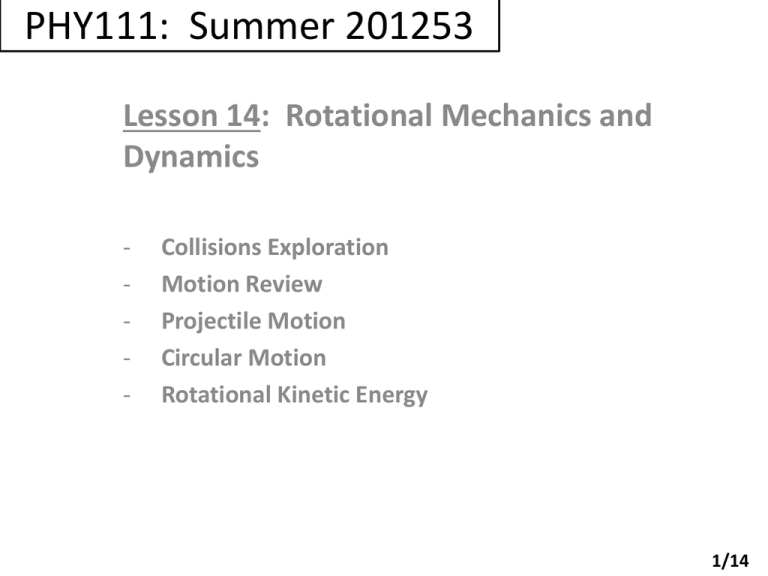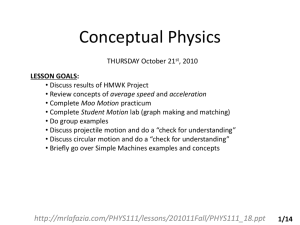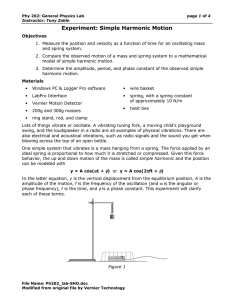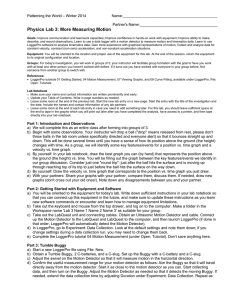Lesson 14 - MrLaFazia.com
advertisement

PHY111: Summer 201253 Lesson 14: Rotational Mechanics and Dynamics - Collisions Exploration Motion Review Projectile Motion Circular Motion Rotational Kinetic Energy 1/14 Newton’s Laws Vocab. Answers Below are the solutions for the Force Vocab. sheet [which you just turned in]. Let’s review the original questions and see how you did! 1. 2. 3. 4. 5. 6. 7. 8. 9. 10. 11. 12. 13. 14. C V L N T Q O S (1st) P K A M H G 15. 16. 17. 18. 19. 20. 21. 22. 23. 24. R J B E I D W F U S (2nd) 2/14 Concept Review • Average Speed v=d/t d v t • Acceleration a = change in velocity / time Recall: The ONLY difference between “Speed” and “Velocity” is that VELOCITY takes into account DIRECTION! ∆v a t 3/14 Student-Guided Simulations • Disperse to your computers, iPads, smart phones, &tc. • Your lab report will consist of a summary of your group experiments (each game linked to, below) as they relate to momentum, impulse, collisions, forces, and motion. [Note: You do NOT have to go through ALL of the levels…just enough to make connections to the bold words/concepts, above]. • Game 1: – http://www.funny-games.biz/wrecking-ball-physics.html • Game 2: – http://www.physicsgames.net/game/Energy_Physics.html • Game 3: – http://www.physicsgames.net/game/Ragdoll_Cannon_4.html 4/14 Projectile Motion video clips FROM THESE FILMS, you need to make sure you have understood the following concepts: – describing the main points along trajectory • (honestly, there are too few good resources for this one… instead you should realize that there is a “muzzle velocity” (the speed and direction at which a projectile leaves its initial point), an “apex” (where the vertical motion is ZERO), and of course the fact that it takes the same amount of time to REACH the apex from the zero-height mark as it takes to get back DOWN from it. – “optimal angle” and “angle equivalence” – http://www.youtube.com/watch?v=tZzIRYPaNcg (Interactive Physics demo) – http://www.youtube.com/watch?v=N0Hrv9XFHk&playnext=1&list=PLE65DF8D0F83FF77E (see figure 6.22 on pg. 117 for clarification on this one) – Horizontal-motion independence from gravity’s effect – http://www.youtube.com/watch?v=qErh402eJgI (another Paul Hewitt!) – http://www.youtube.com/watch?v=SaxokSmKK3U (another Derek Owens!) – http://www.youtube.com/watch?v=cxvsHNRXLjw – CHECK-for-UNDERSTANDING: P. 130 #28 5/14 Echo-Location & the Motion Detector Discuss how echo-location works and review how the motion detector (using the LabQuest datalogger) functions to simulate this natural process. Carry out a Ball-Toss Experiment! Once you have tried it, I will show you the graph that I got from my own experimentation, and explain the position, velocity, and acceleration graphs. 6/14 Student Motion (Part 1 of 4) • Setup your graph in LoggerPro to look similar to the one on to the left, here. Special Note: Since you are using LabQuests instead of LoggerPro (as my instructions intone), you may need to just use the default graph settings. 1. Walk very slowly and steadily away from the detector. Keep the result and label as #1. 2. Walk medium fast and steadily away from the detector. Keep the result and label as #2. 3. Walk slowly and steadily toward the detector from a few meters away. Keep the result and label as #3. 4. Walk medium fast and steadily toward the detector. Keep the result and label as #4. Q1: Try different speeds. How does the graph show different speeds for a distance vs. time graph? Q2: Describe the difference between you walking TOWARD the detector and walking AWAY from it. 7/14 Student Motion (Part 2 of 4) • Setup your graph in LoggerPro to look similar to the one on to the left, here. As a group, sketch out on your paper a prediction for the position-vs-time graph that would result if a person starts 1 m away from the detector, walks away slowly and steadily, pauses for 4 seconds, and then walks quickly and steadily away. Now actually try it! Q3: Was your prediction the same (within reason) of your final result? (Describe how it was different, if applicable). 8/14 Student Motion (Part 3 of 4) • Setup your graph in LoggerPro to look similar to the one up above, here. Try to match this graph. (Note that the second slope is greater than the first for the changing position!) Q4: How did you change your motion in order to produce the two differently sloped parts of the graph? 9/14 Student Motion (Part 4 of 4) • Setup your graph in LoggerPro to look similar to one of those up above, here. Try to match these graphs. (Note that we are no longer dealing with only straight lines!) Q5: What do we call this characteristic of motion that causes curved lines on position vs. time graphs? 10/14 Group Examples • Work through these… P. 48 #’s 2, 3, 5, 8; 12. (Get together in separate groups and present!) 11/14 Circular Motion • Note: We will discuss this in greater detail when we look at Planetary and Satellite motion. – define: “centripetal acceleration” (&tc.) • full definition of acceleration: “change in…” – equation: solving for the acceleration that keeps an object moving along a circular path – examples of Forces that cause this acceleration – CHECK-for-UNDERSTANDING: • “A ball attached to a string is spun around at a constant speed (assume the ball is level with the person’s hand, vertically). If the distance between the center of the ball and the part of the string being held is 0.4 meter, and the ball is clocked at going 5 m/s, what value is the acceleration that keeps the ball moving in a circular path? Also, what is causing this acceleration?” 12/14 Grades/Assignments: Labs 10 and 11 should be turned in for grading by the end of the lesson. 13/14 Looking Ahead: Lesson 15 will be an online class. It will be the first half of the Earth-Space tie-ins—showing the connections to all of the material covered throughout the course. 14/14



